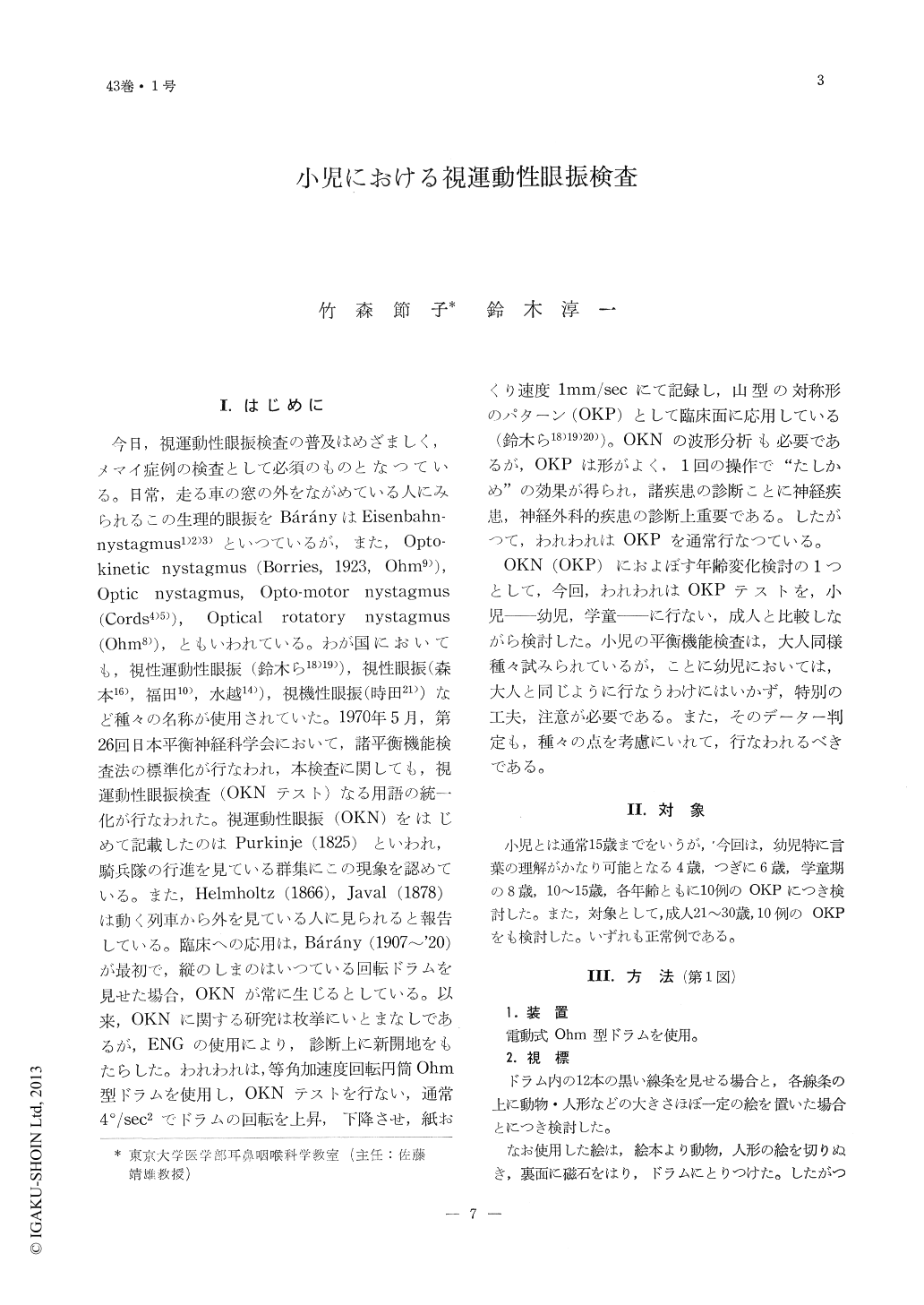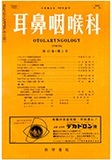Japanese
English
- 有料閲覧
- Abstract 文献概要
- 1ページ目 Look Inside
I.はじめに
今日,視運動性眼振検査の普及はめざましく,メマイ症例の検査として必須のものとなつている。日常,走る車の窓の外をながめている人にみられるこの生理的眼振をBárányはEisenbahnnystagmus1)2)3)といつているが,また,Optokinetic nystagmus(Borries,1923,Ohm9)),Optic nystagmus,Optomotor nystagmus(Cords4)5)),Optical rotatory nystagmus(Ohm8)),ともいわれている。わが国においても,視性運動性眼振(鈴木ら18)19)),視性眼振(森本16),福田10),水越14)),視機性眼振(時田21))など種々の名称が使用されていた。1970年5月,第26回日本平衡神経科学会において,諸平衡機能検査法の標準化が行なわれ,本検査に関しても,視運動性眼振検査(OKNテスト)なる用語の統一化が行なわれた。視運動性眼振(OKN)をはじめて記載したのはPurkinje(1825)といわれ,騎兵隊の行進を見ている群集にこの現象を認めている。また,Helmholtz(1866),Javal(1878)は動く列車から外を見ている人に見られると報告している。臨床への応用は,Bárány(1907〜'20)が最初で,縦のしまのはいつている回転ドラムを見せた場合,OKNが常に生じるとしている。以来,OKNに関する研究は枚挙にいとまなしであるが,ENGの使用により,診断上に新開地をもたらした。われわれは,等角加速度回転円筒Ohm型ドラムを使用し,OKNテストを行ない,通常4°/sec2でドラムの回転を上昇,下降させ,紙おくり速度1mm/secにて記録し,山型の対称形のパターン(OKP)として臨床面に応用している(鈴木ら18)19)20))。OKNの波形分析も必要であるが,OKPは形がよく,1回の操作で"たしかめ"の効果が得られ,諸疾患の診断ことに神経疾患,神経外科的疾患の診断上重要である。したがつて,われわれはOKPを通常行なつている。
OKN(OKP)におよぼす年齢変化検討の1つとして,今回,われわれはOKPテストを,小児―幼児,学童―に行ない,成人と比較しながら検討した。小児の平衡機能検査は,大人同様種々試みられているが,ことに幼児においては,大人と同じように行なうわけにはいかず,特別の工夫,注意が必要である。また,そのデーター判定も,種々の点を考慮にいれて,行なわれるべきである。
Optokinetic patterns (OKP) in children werestudied for examining the factor of aging on these patterns. Ten normal children of three different age groups, 4, 6, and 8 years old were tested and compared to those higher in age, 10-15 and 21-30 years old. Optokinetic stimuli were given in accordance to the original OKP test, i. e., acceleration and deceleration of ±4°/sec2 and the maximum speed of 160°/sec. Optokinetic nystagmus induced was recorded by ENG with the paper speed of 0.1cm/sec and 0.5cm/sec. The former was executed for obtaining patterns and the latter was to count nystagmic beats. Test-subjects were seated at the center of the drum for optokinetic stimulation. The visual targets were providedby means of 12 black 3 cm wide vertical stripes and/or of the pictures showing animals or dolls which were placed on each of the vertical stripes
The present study showed that children older than 8 years of age could be regarded as adults in so far as the ability of eliciting optokinetic patterns concerned. In testing younger children of the ages of 4 and 6 years old, it appeared that better responses of nystagmus was obtained when pictures were used as targets rather than the vertical stripes ; especially in elevating the slow phase velocity of nystagmus but not necessarily for increasing the number of nystagmic beats.

Copyright © 1971, Igaku-Shoin Ltd. All rights reserved.


